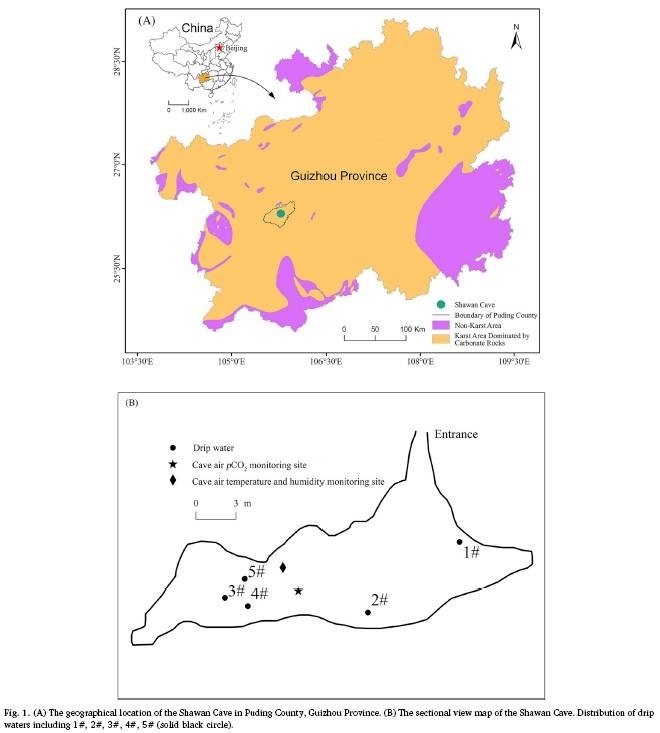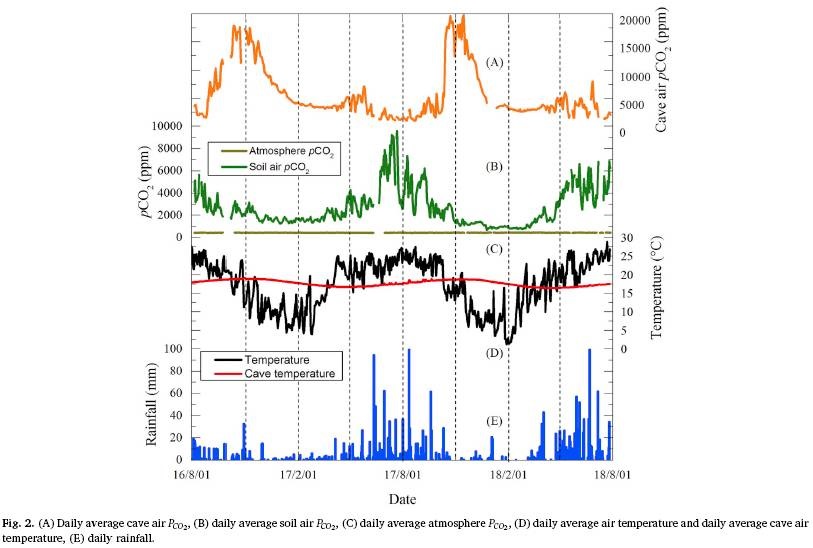Shawan Cave drip water carbon isotope and hydrogeochemistry variations dataset (2016-2018)
Clicks:887
|
DOI
|
|
|
Key words
|
Shawan Cave,carbon isotope,hydrogeochemistry
|
|
Related data
|
The speleothem stable carbon isotope (δ13C) is an important proxy for paleoclimate reconstruction. Understanding the stable carbon isotope composition of dissolved inorganic carbon (δ13CDIC) in drip water is crucial for the interpretation of speleothem δ13C signals. In this study, we present two years of drip water δ13CDIC data and its hydrogeochemistry variables (e.g. PCO2, Ca2+, Mg/Ca, SO42?, pH, drip rate, saturation index of calcite, electrical conductivity) in the Shawan Cave. We also conducted continuous in situ monitoring of PCO2 in the atmosphere, soil air, and cave air and microenvironmental factors. The results show that cave air CO2 primarily originates from soil air CO2, but there is an unsynchronous seasonal variation between cave air CO2 and soil air CO2, which is likely caused by cave ventilation. Cave ventilation is also responsible for seasonal variations in drip water δ13CDIC and speleothem growth. Cave air exchange leads to higher drip water δ13CDIC and rapid speleothem growth in the spring and summer seasons, and cave air stagnation results in lower drip water δ13CDIC and slow speleothem growth. The impact of isotopically light CO2 of soil air on drip water δ13CDIC during spring and summer seasons is more than during autumn and winter seasons, where the more isotopically light CO2 of soil air is enriched by drip water under cave air exchange conditions. Since speleothems growth is rapid in the spring and summer seasons, the speleothems δ13C of the Shawan Cave have the potential to record climate information for the spring and summer seasons. Additionally, by comparing the speleothem δ13C values of eleven caves, we found that paleoclimate signals recorded by speleothem δ13C revealed different seasonal biases under different ventilation types. Therefore, it is necessary to determine the cave ventilation type in order to understand how speleothem δ13C responds to climate change in a ventilated cave.
|
|
Data description
|
a. Description of Intellectual Property Rights
When using a dataset, please refer to the following documents in the article:
Lyu, Y., Luo, W., Wang, Y., Zeng, G., Wang, Y., Cheng, A., … Wang, S. 2020. Impacts of cave ventilation on drip water δ13CDIC and its paleoclimate implication. Quaternary International. doi:10.1016/j.quaint.2020.03.050
b. The data labels refer to the following specifications:
Data sources refer to the following specifications:
Chinese Expression:
数据来源于国家科技资源共享服务平台-国家地球系统科学数据中心(http://www.geodata.cn)-东亚古环境科学数据库(http://paleodata.ieecas.cn/index.aspx);
English Expression:
East Asian Paleoenvironmental Science Database (http://paleodata.ieecas.cn/index.aspx),National Earth System Science Data Center, National Science & Technology Infrastructure of China (http://www.geodata.cn).
Acknowledgments refer to the following specifications:
Acknowledgments in Chinese:
感谢国家科技资源共享服务平台-国家地球系统科学数据中心(http://www.geodata.cn)-东亚古环境科学数据库(http://paleodata.ieecas.cn/index.aspx)提供数据支撑。
Acknowledgments in English:
Acknowledgement for the data support from “East Asian Paleoenvironmental Science Database (http://paleodata.ieecas.cn/index.aspx),National Earth System Science Data Center, National Science & Technology Infrastructure of China. (http://www.geodata.cn)”.
c. Contacts
Name: Yina Lyu, Weijun Luo, et al & Data processing group
Company: Institute of Earth Environment, Chinese Academy of Sciences
Tel: 029-62336213
Email: eapsd@ieecas.cn
|
|
Dataset format
|
EXCEL
|
|
Data type
|
Project Data/Projects of CAS/Strategic pilot science and technology projects
|
|
Data sources
|
authors supply
|
|
Enclosure
|
[download]
|
|
Related pictures
|
 
|
 Contact card Contact card |
 |
Name:Dr. Hongli Zhao |
E-mail:zhaohl@ieecas.cn |
| Company:IEECAS |
Telephone:029-62336213 |